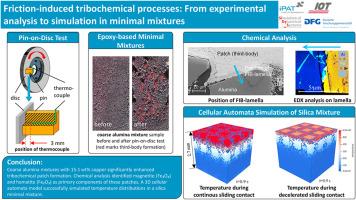摩擦引起的摩擦化学过程:从实验分析到最小混合物的模拟
IF 6.1
1区 工程技术
Q1 ENGINEERING, MECHANICAL
引用次数: 0
摘要
摩擦诱导的摩擦化学反应在高负荷摩擦系统的摩擦行为、磨损和性能中起着至关重要的作用。本研究考察了环氧基最小混合物中第三体层的形成,作为基础摩擦化学研究的模型系统。针盘试验进行了最小的混合物含有磨料和铜在不同的成分。含有约15 wt%铜的粗氧化铝样品显示出明显的表面斑块形成。利用扫描电镜(SEM)、能量色散x射线能谱(EDX)、拉曼光谱(Raman)、聚焦离子束(FIB)和透射电镜(TEM)进行成像和化学分析,发现这些斑块主要由磁铁矿(Fe3O4)和赤铁矿(Fe2O3)组成,并与样品表面机械结合。纳米硬度测试表明,该贴片的硬度高于基体和磨料。热重分析(TGA)表明,含粗磨料的混合物在较低温度下热降解。为了评估温度在斑块形成中的作用,建立了三维元胞自动机热模型来模拟非均质摩擦材料中的热分布。对二氧化硅混合物的初步模拟预测,在连续滑动接触下,瞬态表面温度高于800°C, 2.7 mm深度下表面温度约为70°C,与文献和实验观察结果一致。然而,扩展试验表明,斑块的形成不仅取决于温度,还取决于磨料粒度和材料性能。该研究为滑动摩擦接触中摩擦学诱导的第三体形成提供了基本见解,并支持了摩擦学反应预测模型的开发,有助于优化摩擦材料以提高耐磨性。本文章由计算机程序翻译,如有差异,请以英文原文为准。

Friction-induced tribochemical processes: From experimental analysis to simulation in minimal mixtures
Friction-induced tribochemical reactions play a crucial role in the frictional behaviour, wear, and performance of high-load tribological systems. This study examines the formation of third-body layers in epoxy-based minimal mixtures as a model system for fundamental tribochemical investigations. Pin-on-disc experiments were conducted on minimal mixtures containing abrasives and copper in varying compositions. Coarse alumina samples with around 15 wt% copper exhibited significant formation of surface patches. Imaging and chemical analysis using scanning electron microscopy (SEM), energy-dispersive X-ray spectroscopy (EDX), Raman spectroscopy, focused ion beam (FIB), and transmission electron microscopy (TEM) revealed that these patches consist mainly of magnetite (Fe3O4) and hematite (Fe2O3), and are mechanically bonded to the sample surface. Nanohardness tests showed that the patches were harder than the matrix and the abrasives. Thermogravimetric analysis (TGA) indicated that mixtures containing coarse abrasives degraded thermally at lower temperatures. To evaluate the role of temperature in patch formation, a three-dimensional cellular automata thermal model was developed to simulate heat distribution in the heterogeneous friction materials. Preliminary simulations for the silica mixture predicted transient surface temperatures above 800 °C under continuous sliding contact and subsurface temperature around 70 °C at 2.7 mm depth, consistent with literature and experimental observations. However, extended tests showed that patch formation depends not only on temperature, but also on abrasive particle size and material properties. This study provides fundamental insights into tribochemically induced third-body formation in sliding frictional contacts and supports the development of predictive models for tribochemical reactions, aiding the optimisation of friction materials for improved wear resistance.
求助全文
通过发布文献求助,成功后即可免费获取论文全文。
去求助
来源期刊

Wear
工程技术-材料科学:综合
CiteScore
8.80
自引率
8.00%
发文量
280
审稿时长
47 days
期刊介绍:
Wear journal is dedicated to the advancement of basic and applied knowledge concerning the nature of wear of materials. Broadly, topics of interest range from development of fundamental understanding of the mechanisms of wear to innovative solutions to practical engineering problems. Authors of experimental studies are expected to comment on the repeatability of the data, and whenever possible, conduct multiple measurements under similar testing conditions. Further, Wear embraces the highest standards of professional ethics, and the detection of matching content, either in written or graphical form, from other publications by the current authors or by others, may result in rejection.
 求助内容:
求助内容: 应助结果提醒方式:
应助结果提醒方式:


